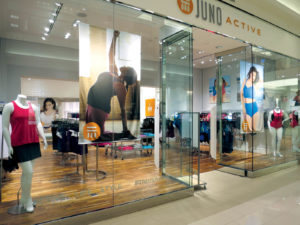
The effects of society’s ever-increasing digital dependency, overabundance of shopping malls and shifting spending habits are not doing the retail industry any favors. But its future is not all doom and gloom.
A study released earlier this year by the National Retail Federation (NRF) and IBM found that most members of Generation Z—the generation following millennials—prefer to shop in brick-and-mortar stores. The results, summarized on nrf.com, conclude that, with this population set to reach 2.6 billion by 2020, retailers must create more interactive engagement around their brands.
The New York Times echoed that conclusion in April when it reported that many investors still believe online retail and traditional stores can coexist and thrive together, noting that catchy displays and powerfully branded environments are a crucial method retailers should embrace to continue to prosper. That’s where fabric has an opportunity to make all the difference.
“The industry is trending up tremendously for the use of fabric in retail environments,” says Michael Compton, product marketing manager of Carmel, Ind.-based Top Value Fabrics. “The varied look, feel and image color brilliance, as well as overall performance of fabric in retail environments, combine to make this
a consistent growth area.”
Gary Teich, partner at Color X in New York City, agrees: “Now, more than ever, retailers need to have branding and visual impact. Fabrics tend to have a softer and, in some cases, more upscale feel. Using a printed sheer fabric in a store or in windows keeps the environment nice and open. The large scale of fabric gets the message or images out there in high quality and great color saturation.”
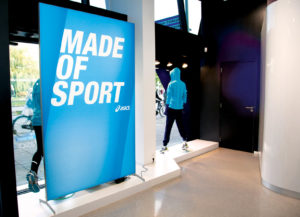
Flexibility is key
Of fabric’s many assets, flexibility is the primary advantage it offers the retail industry. The visual branding company Cees Smit Inc., a member of the Van Straaten Group—with offices in both the Netherlands and Germany—lists this quality as the first pillar of visual branding, which should be “overwhelming yet flexible so that the themes and messaging can be changed on a daily, weekly or monthly basis. Only then, a retailer remains agile. That is why flexibility is so important,” the website reads.
Because fabric can be easily shipped at relatively low costs, retailers have more options as to how and when they switch up their displays. “Fabric is engineered to be folded up and stuck in a box,” says Mark Shaneyfelt, director of sales and marketing for printable textiles at Aurora Specialty Textiles Group, Yorkville, Ill. “If a retailer has an upcoming sale and wants to print new signage and distribute to 15 stores for installation, fabric is perfect for that. It’s cheap to ship, and they can just pull it out of the box and install it without much effort.”
Flexibility is also an advantage when it comes to display possibilities, from point-of-purchase signage, banners and front- or backlit lightboxes to canvas wraps and silicone edge graphics (SEG). Shaneyfelt says the first discussion he has with clients is about what technology they employ and then what end-use applications they’re looking for. “Their answer determines how we go about working toward the best solution,” he says.
“After discussing what the application will be used for, we can make the best recommendation,” Teich notes. “Is it used indoors or outdoors, short term or long term? Is it in direct sunlight? What size is it, how many are in the order, what is the budget, the timing? All of these details influence what material is best for the specific job.”
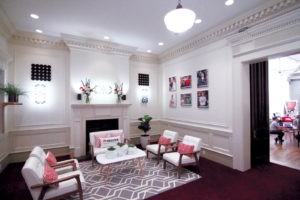
Sleek superiority
Though each format offers a unique set of benefits, SEG applications are quickly becoming a favorite. “Silicone edge graphics are replacing a lot of things in a lot of different environments,” notes Tom Trutna, president
of Eagan, Minn.-based Big Ink. “Anything new and different helps retailers look unique, and there’s certainly a cool look to these frames. They’re almost edgeless—very clean and elegant.” In addition, he adds, the cost of setting up a frame is fairly low. And once installed, fabric can be interchanged as often as a retailer chooses.
It’s not without challenges, though. The amount of tension can make or break its sleek appeal, so fabric must be measured to fit the frame precisely. A band of silicone is sewn to the material, giving it a gummy edge, Trutna explains. When the silicone edge is pushed into a channel in the frame, the friction holds the material in place and keeps it wrinkle-free.
Because fabrics’ stretch characteristics are different, Trutna uses a jig to test fit the fabric first. When attaching it to the frame, he clarifies that two opposite corners should be fitted first. “A mistake people often make is trying to do the top edges or one side first,” he says. That tight, precise fit is crucial to attaining the seamless appearance that draws the customer’s eye.
Installation of the frame itself can be done by store personnel, but for more permanent or complicated installations, Trutna’s team will usually do it on-site, which is not uncommon. “For oversized banners and lightboxes, it is best for a professional to install,” Teich says. “Many require lifts, ladders and a little bit of acrobatics, as some of the spaces are not too accessible.”
Van Straaten CFO Niels van Straaten and his team are familiar with the acrobatics Teich mentions, as they often attach frames to walls or suspend lightbox frames from ceilings. When doing so, he stresses the importance of first drilling holes in the ceiling to ensure electricity is present before installing the cable suspensions.
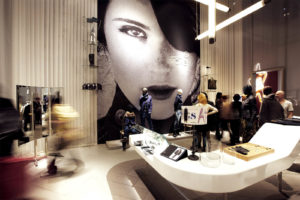
Perfecting the “pop”
The “wow factor” in creating the ultimate display depends on both the application and fabric chosen, Compton notes. “When choosing a fabric, it’s critical that the client looks for fabrics that offer a consistent, bright white point to enhance printed graphics so they pop with color and best support the message the retailer needs to convey to customers.”
Top Value Fabrics’ Supernova product—a knitted polyester compatible with dye-sublimation direct, dye-sublimation transfer, UV and latex ink—is commonly used for backlit frame applications, while its polyester stretch banner fabric DigiStretch is used for non-backlit applications. DigiHeavy, a polyester for direct printing, is frequently used for hanging banners, along with DigiCompetition, a lightweight, wrinkle-resistant fabric engineered with a print-receptive coating. Canvas fabrics are used as more permanent wall-mount signage because of their rich-looking aesthetic, Compton says.
Stretch and wrinkle resistance are must-have qualities. Printability and flame retardancy are also crucial and, depending on the application, qualities such as the hand, weight and degree of translucency factor into determining the right product.
Aurora Textiles brings all of its fabrics in raw so it can customize products for anyone’s exact needs, Shaneyfelt says. “We can do anything from bleaching and dyeing to scouring and sanding—basically everything in the preparation of the surface and then a full range of capabilities of treating and coating.”
Aurora’s White/Black/White product is recommended for banners, as it blocks light from passing through by sandwiching a dark layer between two bright white layers. The company’s polyester Triple White fabric is often used for backlit applications and is compatible with latex, UV and dye-sublimation transfer printing. Shaneyfelt explains that knitted fabrics are well-suited for SEG. “A lot of products can be used in frames, but with knit, the coating engineering and technology allow for the fabric to be stretched and eliminate pinholes.” Aurora also offers a highly sought-after cotton canvas product. “We put a treatment on it for latex, UV and solvent printing that has a rustic look; it’s not bleached to the level of others and is really popular with retailers who want a rustic or Old English look,” Shaneyfelt says.
Teich notes a demand for large-scale fabrics and the impact they create. “Oversized fabrics are very popular, as we can cover entire wall spaces, and they’re also great in large windows,” he says.
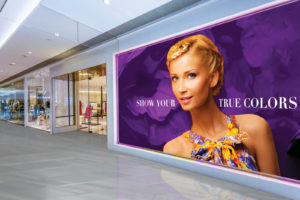
Determined to dazzle
Enhanced printing technology is another reason the retail market remains promising. “Printing with digital dye sublimation, and now latex inks, has increased the popularity of fabric graphics for retail displays,” Compton says. “This is due to the increasing quality and diversity of fabrics available as well as the exceptional quality of the graphics that can be printed and provided in a short turn time.”
“It’s all about the experience,” Trutna stresses. “It can’t just be about a low price every day—the internet will win that game most of the time. Retail is still alive and well if you can create a unique experience people want to go to, and graphics play a big part in that. You can do a lot with simulated products, such as wood looks or unique finishes, without necessarily having to use old wood or old metal.”
“Printability is really what we sell,” Shaneyfelt adds. “When you optimize the printing capabilities, you get a dazzling, eye-catching image that grabs consumers’ attention.”
According to van Straaten, textile printing was being applied to approximately 25 to 30 percent of all square meters his company printed in 2013. “But in 2016, 75 to 80 percent of materials we print are sublimation textiles. The others are UV textiles or rigid materials,” he says. “There’s been a huge increase in textile printing, with sublimation as the future—mostly because it’s a flexible and sustainable way to work and creates an excellent brand experience.”
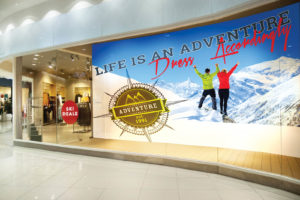
Beyond boxes
Opportunities in retail extend beyond displays. Teich suggests printed props as an example, such as custom scarves, pillows and bedsheets, and curtains.
“Enhancing a retail environment with fabric can begin with curb appeal, starting with attention-getting feather flags designed to entice customers to enter a retailer,” Compton says. “Once inside a retail location, the consumer can be drawn to exceptional backlit and banner graphics that help spotlight specific product promotions for the retailer.”
Aurora Textiles is working on a wall-covering product to provide a complete interior design option for digital printing that also includes upholstery fabrics, Shaneyfelt says, noting that many of his retail clients have plans to convert 75 to 80 percent of their store signage to some type of fabric. “They really want to make the experiences as enjoyable as possible, so they’re doing a lot to dress things up to get more pop.”
Van Straaten is seeing a growing trend in flagship stores: animation frames, which combine fabric with magnetics or TV screens.
Ongoing education
While high-end and specialty retailers were early adopters of phasing out paper and plastic signage, more brands from all market segments—including vehicles, fashion, sporting goods, furniture and home goods—are realizing the benefits of fabric.
“The retailers are catching on,” Shaneyfelt confirms. “Where a lot of education needs to happen is with the printers. There’s a learning curve if a printer doesn’t have a lot of experience with fabrics. It’s a different animal than rigid or paper or plastics. Retailers have accepted and see the value in fabric; it’s getting that comfort level throughout the chain that’s a challenge.”
Van Straaten says most retailers he works with are willing to listen to alternatives—they just need to be in a similar price range as their current products. “You have to upsell the benefits to make sure they adapt the material completely in a way that makes all of the products work together. We try to focus on the benefits of putting the frame down the first time, and then you have some flexibility after that for an extra sales pitch.”
“The best way to educate customers on what your products can do is to show them,” Compton adds. “Illustrate the pure performance of your fabrics and consult with them on the best fabric fit for their desired application. Then work with them closely as they create and achieve success.”
Holly Eamon is an editor and writer based in Minneapolis, Minn.
Improved printing technologies and more eco-conscious customers are helping both the fabric and retail industries meet the growing need to leave a lighter ecological footprint.
“Major retailers look to fabric not only to provide brilliant graphics but also as they seek print media that meets the goals they have for sustainability,” says Michael Compton, product marketing manager of Top Value Fabrics, listing the following as the most common objectives he hears from them: REACH compliant, recyclable, printed with water-based inks, and better packaging, handling and installation. “The relative light weight of fabric can save a significant amount of fuel for shipping, and fabrics are primarily printed on green-based systems such as water-based dye-sublimation and latex ink printers.”
Niels van Straaten, CFO, Van Straaten, also has more clients—specifically high-end telecommunications providers and IT manufacturers—demanding digital textile printing because it’s more sustainable. Water-based inks’ lack of odor is also an advantage, he notes, when compared with PVC products.
In addition to printing methods, Tom Trutna, president of Big Ink, is hoping for more strategies for recycling fabric. “There are some good options right now, such as grinding it and using it as fiber for other things,” he says, also mentioning the increase in more creatively produced fabrics, such as a poly-based product made entirely of milk jugs. “I think things will only get better.”
Van Straaten works with a children’s retailer that reuses textile banners or prints by cutting and sewing them into bags. “But it remains challenging to ship a banner from Amsterdam to Tokyo, for example, and then get that banner back,” he says. “You have to find a partner who can deal with logistics and find worldwide parties that can help you degrade the product and make the raw material again.”
 TEXTILES.ORG
TEXTILES.ORG


